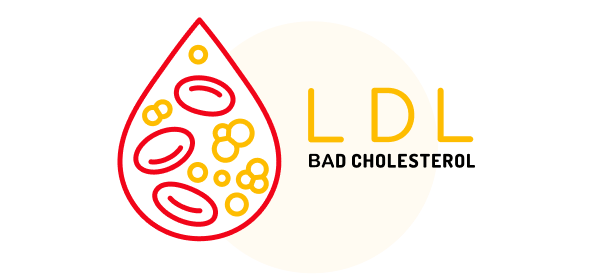

Cholesterol is a fatty substance vital for the normal functioning of your body. While a certain amount of cholesterol is necessary for good health, excessive levels can be harmful.
When the body cannot eliminate the excess, it accumulates in the artery walls, forming atheroma (fatty deposits or plaque).
If left untreated, this fatty build-up leads to a hardening or narrowing of your arteries, which can cause a heart attack or stroke.
High blood cholesterol often presents no noticeable signs or symptoms, leaving many unaware of their condition until they experience serious health issues.

“Good cholesterol”, or high-density lipoprotein (HDL) cholesterol, helps to carry excess bad cholesterol away from your arteries back to the liver to be broken down and removed from the body. A high level of HDL-cholesterol protects against heart disease.

“Bad cholesterol”, or low-density lipoprotein (LDL) cholesterol, contributes to the build-up of fatty deposits in your arteries, a process known as atherosclerosis. Too much LDL-cholesterol is a major driver of atherosclerotic cardiovascular disease (ASCVD).
ASCVD is an umbrella term used to describe cardiovascular diseases caused by the build-up of fatty deposits (plaque) in the arterial walls, resulting in blocked arteries (atherosclerosis).5
It is a leading cause of heart attacks and strokes, which accounts for 85% of cardiovascular-related deaths.6 Close to 40% of the adult population are at risk of ASCVD and are too often undiagnosed until a cardiovascular event occurs.7
 Depending on your lipid profile and cardiovascular risk, diet and exercise alone may not be sufficient for effective cholesterol management.
Depending on your lipid profile and cardiovascular risk, diet and exercise alone may not be sufficient for effective cholesterol management.
These key steps can help you maintain a healthy lifestyle and reduce your risk of heart disease and stroke.8
The type of fat (saturated or unsaturated fat) in your diet will affect the amount of good and bad cholesterol levels in your bloodstream.
Foods that are rich in animal-based saturated fats are also high in cholesterol content.
Good fat comprises monosaturated and polyunsaturated fats sourced from some liquid non-tropical plant oils, nuts, seeds and fatty fish:
These foods function to:

Oils (e.g. corn, sunflower, soybean, canola, olive, peanut, sesame oils)

Avocado

Fatty fish (e.g. mackerel, tuna, salmon, sardines)

Nuts & seeds (e.g. chia seeds, sunflower seeds, flaxseeds, almond, walnuts)
Bad fat consists of saturated fats sourced mostly from animals, such as fatty meat or full-fat dairy or tropical oils. Trans fats are formed when vegetable oils undergo hydrogenation to harden liquid to produce fats such as hard margarines & shortenings. Trans fats are often found in commercially fried and baked foods, which often use vegetable shortening and hydrogenated oils.
These foods function to:

Animal fats (e.g. fatty meats, lard)

Some baked goods

Full-fat dairy products (e.g. full-cream milk, butter)

Fried foods

Tropical oils (e.g. coconut and palm oils)

Hard margarines & shortenings

Products containing hydrogenated/partially hydrogenated oils
There are various types of medications that can help lower your cholesterol, if diet and lifestyle changes are not adequate for effective cholesterol management.
Speak to your doctor on the best option for you, and for guidance on dosage required for your specific condition.

Lowers cholesterol in the blood by inhibiting an enzyme that makes cholesterol.

Prevents cholesterol from being absorbed in the intestine.

Lowers triglyceride levels in the blood and has a mild effect in lowering LDL-C.

Binds and inactivates a protein to lower LDL-C.

Prevents the production of a protein in the liver to lower LDL-C.
Disclaimer:
This illustration is intended to provide an overview of HSA approved medication to manage bad cholesterol.11
The above information is not meant to replace medical advice by healthcare professionals. Kindly speak to a healthcare professional to know more details. Not all medications may be suitable or needed for all patients.
1World Heart Federation. Prevention. Available at: https://world-heart-federation.org/what-we-do/prevention/. [Last accessed: September 8, 2025]
2Singapore Heart Foundation. Cholesterol Levels. Available at: https://www.myheart.org.sg/heart-news/cholesterol-levels/#:~:text=Cholesterol%20in%20Adults&text=According%20to%20 the%20National%20Population,2020%20to%2031.9%25%20in%202022. [Last accessed: September 8, 2025]
3Data on File.
4Mayo Clinic. High Cholesterol. Available at: https://www.mayoclinic.org/diseases-conditions/high-blood-cholesterol/symptoms-causes/syc-20350800 [Last accessed: September 8, 2025]
5GoodRx. Atherosclerotic Cardiovascular Disease (ASCVD): Causes, Diagnosis, and Treatments. Available at: https://www.goodrx.com/health-topic/heart/atherosclerotic-cardiovascular-disease-ascvd. [Last accessed: September 8, 2025]
6World Health Organization (WHO). Cardiovascular diseases (CVDs). Available at: https://www.who.int/news-room/fact-sheets/detail/cardiovascular-diseases-(cvds). [Last accessed: September 8, 2025]
7Croí Heart & Stroke Charity. ASCVD. Available at: https://croi.ie/ascvd/ [Last accessed: September 8, 2025]
8American Heart Association. Reduce Your Risk of ASCVD. Available at: https://www.heart.org/-/media/Files/Health-Topics/Cholesterol/Reduce-ASCVD-risk.pdf. [Last accessed: September 8, 2025]
9American Heart Association. Cholesterol Medications. Available at: https://www.heart.org/en/health-topics/cholesterol/prevention-and-treatment-of-high-cholesterol-hyperlipidemia/cholesterol-medications. [Last accessed: September 8, 2025]
10Health Hub. Getting the Fats Right!. Available at: https://www.healthhub.sg/live-healthy/getting-the-fats-right. [Last accessed: September 8, 2025]
11Agency for Care Effectiveness – ACE. ACE Clinical Guidance – Lipid management – focus on cardiovascular risk. Available at: https://www.ace-hta.gov.sg/docs/default-source/acgs/lipid-management-focus-on-cardiovascular-risk-dec23dede729e8827 4a02a89acac9718c649a.pdf. [Last accessed: September 8, 2025]